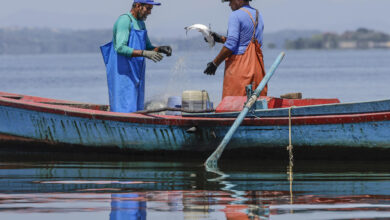Reviving Brazil’s Atlantic Forest: A Corridor for Golden Lion Tamarins
In Brazil's Rio de Janeiro, a dedicated group is planting a green corridor to safeguard the endangered golden lion tamarin in the fragmented Atlantic Forest.

Photo: Lutz Fischer-Lamprecht
The Latin American Post Staff
Escucha este artículo
Leer en español: Reviviendo el bosque atlántico de Brasil: un corredor para los titíes león dorado
A Green Mission in Rio's Hinterlands
In the rural hinterlands of Rio de Janeiro, a passionate cohort of young environmentalists has embarked on an ambitious project under the scorching sun. Their mission? To establish a green corridor that will serve as a safe passage for the region's most iconic and endangered inhabitant, the golden lion tamarin. Last week, they planted 300 tree seedlings, a small yet significant step towards connecting fragmented forest patches and ensuring the survival of this distinctive monkey.
The golden lion tamarin, with its striking copper-colored fur and mane-like facial hair, symbolizes Brazil's rich biodiversity. However, its existence hangs in the balance, with fewer than 5,000 individuals remaining in the wild. This tiny primate is exclusive to Brazil's Atlantic Forest, an ecosystem ravaged by centuries of deforestation for agriculture, urban development, and cattle pastures.
Reforestation in a Vanishing Landscape
The recent reforestation effort comes as a beacon of hope in a region where the Atlantic Forest has dwindled to a mere fraction of its original expanse. Historically, this biome covered 330 million acres along Brazil's coast, but today, less than 15% remains, severely impacting the habitat of the golden lion tamarin.
The restored land once belonged to a ranch owner who had cleared it for cattle grazing. This transformation from pasture back to forest is crucial. Golden lion tamarins are forest dwellers and need connected habitats to thrive and maintain genetic diversity. Isolation leads to inbreeding and makes them easy prey for larger predators.
Supporting these efforts is Sarah Darwin, the great-great-granddaughter of Charles Darwin. She and a team of young naturalists retracing Darwin's historic expedition applauded the project's contribution to conservation and biodiversity. This initiative resonates deeply with Darwin's theory of evolution and his profound experiences in the Brazilian Mata Atlantica.
The Tragic History of the Atlantic Forest
The destruction of the Atlantic Forest began with the Portuguese colonization in the 16th century, escalating with the growth of sugar cane and coffee plantations. Urban expansion and cattle ranching further contributed to its demise. By the 1970s, the golden lion tamarin population plummeted to just 200, prompting scientists and conservationists to intervene urgently.
This monkey became a national emblem of wildlife preservation in Brazil, even gracing the country's 20-real currency note. Efforts to save the species involve buying land from farmers and ranchers to reforest and recreate the monkeys' natural habitat. This slow, expensive, but rewarding process has been spearheaded by the Golden Lion Tamarin Association (AMLD) and other environmental groups, who meticulously maintain these reforested areas, especially crucial in the early years of growth.
Their work is showing results. The once barren hills purchased by AMLD in 2018 now boast lush, vibrant forests teeming with diverse wildlife. Despite a severe setback from a yellow fever outbreak in 2018, the golden lion tamarin population has rebounded to around 4,800 individuals, the highest since conservation efforts began.
Also read: Brazil's Largest City Still Ravaged by Storm
Restoring an Entire Ecosystem
This story is about the revival of a species and the restoration of an entire ecosystem. The Atlantic Forest is known for its incredible biodiversity, home to thousands of species of plants, birds, and other animals, many of which are found nowhere else on Earth. The reforestation efforts not only benefit the golden lion tamarin but also contribute to the preservation of this unique biome.
The project in Rio de Janeiro's rural interior exemplifies the power of conservation and the impact of human intervention in reversing environmental degradation. It's a testament to the fact that with dedicated effort and community involvement, it's possible to restore natural habitats and protect endangered species.
In essence, planting a green corridor for the golden lion tamarin in Brazil's Atlantic Forest is more than a conservation effort; it's a symbol of hope and a reminder of our responsibility to protect the planet's precious biodiversity. As these seedlings grow and forests regenerate, they will provide safe passage for tamarins and stand as a living legacy of environmental stewardship for future generations.




